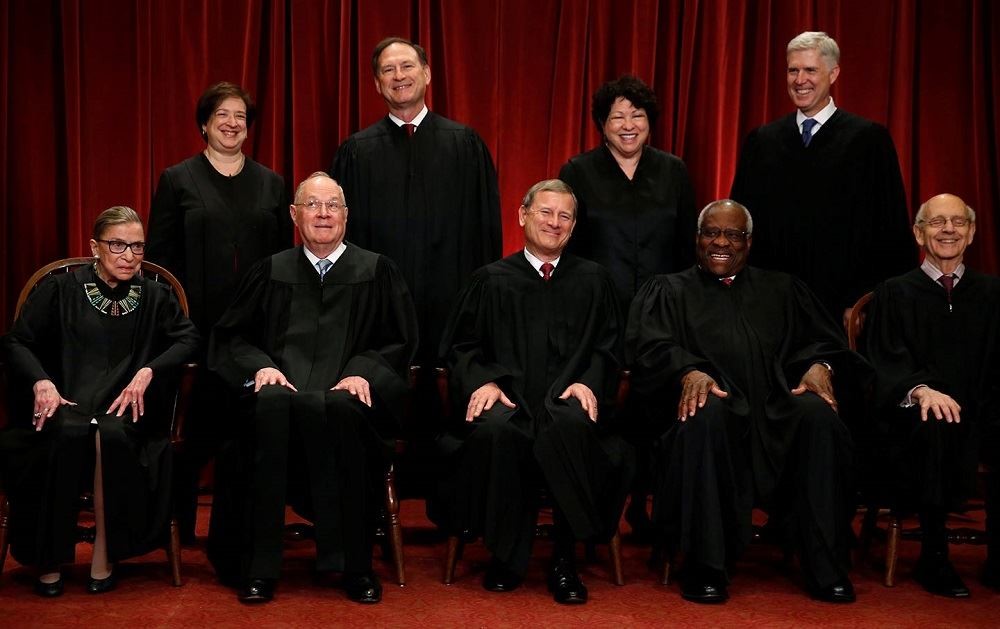What You Need to Know: History, Constitutionality, Usurping Power

|
This article was updated on 04/28/21.
Ads we feature have been independently selected and reviewed. If you make a purchase using the links included, we may earn a commission, which helps support the site. Thank you for your support.
When Judge Anthony McLeod Kennedy, appointed by President Ronald Reagan, announced his retirement from the Supreme Court, that freed President Trump to appoint his successor.
The Supreme Court is a unique institution in all the world. If you live in this country (USA), this article will explain what you need to know about the Supreme Court, or as it is sometimes called, SCOTUS, (Supreme Court of the United States).
Supreme Court Justice is a Lifetime Gig
Once seated, a supreme court justice can hang up his or her resume. There is no expiration term on this job unlike regular judges who must pander for your votes at each election cycle. The president appoints SCOTUS justices according to his or her political persuasion. For this reason some have argued that the ability to appoint supreme court justices is one of the most powerful tools that sitting presidents has. Presidential terms in office are fleeting, a mere four to eight years, but their policies embedded in their SCOTUS selection endure far beyond their years.
This is the reason why President Obama’s appointment of Sonia Maria Sotomayor was so disturbing to constitutionally-aligned Americans and even foreign-born critics. She indicated that she intended to pass rulings based on her personal sentiments (“empathy,” she said) rather than on the basics of the constitution which she is bound by oath to comply with and defend. This is to say, not even contemporary sentiments, no, just her own as she defined herself, a woman of color. In other words, incrementally change the country based on her personal life experiences, not the citizens.
I would hope that a wise Latina woman with the richness of her experiences would more often than not reach a better conclusion than a white male who hasn’t lived that life.
Sonia Maria Sotomayor
Well, that statement is just sexist and racist.
An unabashed left-wing liberal radical, she also ruled against the Stolen Valor Act which prevents individuals from portraying themselves as armed forces heroes for false personal gain. This (from my perspective as a veteran) is a poor choice for this high office. What possible reason could the be to oppose this other to discredit veterans? Shame.
So there’s that.
President Biden and Court-Packing
Joe Biden, when “campaigning” for office from his basement bunker, claimed that he was not a fan of packing the court with leftist judges. However, after the “election” was over, he began to conceptualize the process. Or perhaps his staff did; it’s not clear.
Congressional Democrats have introduced legislation to expand the Supreme Court from 9 to 13 justices, joining progressive activists pushing to transform the court in order to render “woke” judgments and mold the country into one that complies with Critical Race Theory guidelines. President Donald Trump and Republicans appointed 3 conservative justices in 4 years, including one who was confirmed just days before the 2020 election. Thus, the left is seeking not only to rectify that but to do it in a most unorthodox way. The time-honored tradition, honored by both sides is “retire and replace.” It is a kind of gentleman’s agreement that with this administration has been relegated to the trash-heap of history.
However, House Speaker Nancy Pelosi, D-Calif., told reporters on Thursday she has “no plans to bring it to the floor. I don’t know that that’s a good idea or bad idea. I think it’s an idea that should be considered,” she said of the court expansion plan. “And I think the president’s taking the right approach to have a commission to study such a thing. It’s a big step.” In other words, she’s being a mugwump, playing both sides of the fence. She wants it but knows she will be partially culpable for setting a precedent when the Republicans take the reins in the White House.
History Behind the Supreme Court
The Constitution wisely permitted Congress to decide on the make-up of the Supreme Court although it seems like a conflict of interest. The three branches of government are the executive (the United States President), the legislative (Congress), and the judicial (SCOTUS). The legislative branch first exercised this power with the Judiciary Act of 1789. The act, signed into law by President George Washington, specified that the court would be made up of 6 justices who would serve on the court until they died or retired.
Today there are 9 sitting justices and together they hold more power than arguably anyone on the planet. An odd number makes it hard to reach a tie vote on a ruling. They serve and issue edicts until they retire or die.
Anthony Kennedy Retires
For example, when Supreme Court Justice Anthony Kennedy announced his retirement it set the stage for President Trump to appoint a successor.
Why does this matter? Whoever Trump places on the bench will wield power for years, even decades, long after the presidential torch has passed. This is why the power of the president can last far longer than his term. It doesn’t always work out that way and there is no denial that some justices are flawed.
For example when Justice Roberts “interpreted” Obamacare non-compliance to be a “tax” rather than a “fine” he usurped Congressional authority. Specifically, the Supreme Court has no such authority but they have “assumed” it over time. Like, if I jaywalk enough times without getting busted, it becomes legal. Bullcrap, but there you go.
The Supreme Court Justice Nomination Process
As we mentioned, there are nine Supreme Court justices. One is designated as the Chief Justice and the other eight are Associate Justices. When any one justice dies or retires it makes for a vacancy. Article 2 of the U.S. Constitution makes it clear that the president has the responsibility of nominating a Supreme Court Justice replacement.
The reason for using nine, an odd number, is so when SCOTUS hears a case and rules on it there will not be a tie.
Next the Senate Judiciary Committee holds a hearing to approve the nomination, or not. Following a lengthy question and answer, the committee votes on the prospective justice. If approved, all is good. If not, the process begins anew.
However, there is a fly in the ointment. Republicans usually appoint conservative judges and Democrats, liberal ones. It is very possible that one party will unanimously oppose. In fact, it is not inconceivable that outright political chicanery will take place.
The Nomination of Judge Brett Kavanaugh
The last nomination of Judge Brett Kavanaugh is a good example. After other Democrat stalling techniques had failed, they brought Christine Blasey Ford out of the wings to accuse him of sexual misconduct (he allegedly unsuccessfully tried to force himself on her) some thirty five years ago at a high school party.
One problem is that Sen. Dianne Feinstein (D-Calif.), the top Democrat on the Judiciary Committee had received a letter from Ford regarding the alleged misconduct. But rather than share the letter with the committee as one might expect would be part of the process, she deliberately withheld it, perhaps to use as ammunition when all other delaying tactics had failed.
Ford was found to be making false statements and working with the Democrats to disrupt the process. This “make it up as you go” tactic failed, but not before causing he and his family irreconcilable harm. This is how the radical Democrat left party operates. Can’t win with the facts? Just make it up. Pay stooges to bear false witness. It certainly almost worked when Hillary and the DNC scripted and paid for paid for a fictional dossier in an attempt to impeach President Trump. Yet, no one went to jail. Go figure.
What do you think? Participate in the poll on the side bar to the right.
More Trending Content
- How Health Care Systems Use Clinical Empathy to Support Patients
- Joe Biden and Education; His History and Opinions
- What is Critical Race Theory?
- Theodore Roosevelt: The Man in the Arena
- History & Rationale: Electoral College
- The United States of Trump: A Book Review
Looking for more great content? Visit our main page or partner sites:
I offer article and blog-writing services. Interested? Contact me for a quote!
Did you find this article helpful? Millions of readers rely on information on this blog and our main site to stay informed and find meaningful solutions. Please chip in as little as $3 to keep this site free for all.




